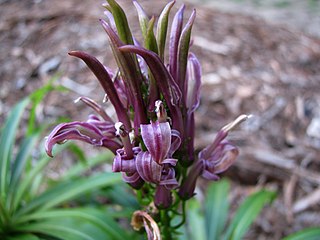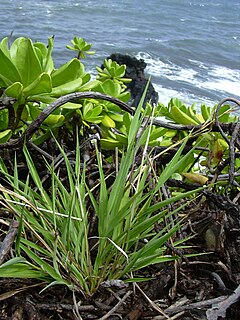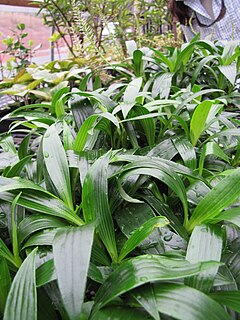
The nene, also known as nēnē and Hawaiian goose, is a species of bird endemic to the Hawaiian Islands. The official bird of the state of Hawaiʻi, the nene is exclusively found in the wild on the islands of Oahu, Maui, Kauaʻi, Molokai, and Hawaiʻi.
Located about 2300 miles (3680 km) from the nearest continental shore, the Hawaiian Islands are the most isolated group of islands on the planet. The plant and animal life of the Hawaiian archipelago is the result of early, very infrequent colonizations of arriving species and the slow evolution of those species—in isolation from the rest of the world's flora and fauna—over a period of at least 5 million years. As a consequence, Hawai'i is home to a large number of endemic species. The radiation of species described by Charles Darwin in the Galapagos Islands which was critical to the formulation of his theory of evolution is far exceeded in the more isolated Hawaiian Islands.
Hawaiian hibiscus are seven species of hibiscus native to Hawaii. The yellow hibiscus is Hawaii's state flower. Most commonly grown as ornamental plants in the Hawaiian Islands are the Chinese hibiscus and its numerous hybrids, though the native Hibiscus arnottianus is occasionally planted.

The Hawaiian lobelioids are a group of flowering plants in the bellflower family, Campanulaceae, all of which are endemic to the Hawaiian Islands. This is the largest plant radiation in the Hawaiian Islands, and indeed the largest on any island archipelago, with over 125 species. The six genera can be broadly separated based on growth habit: Clermontia are typically branched shrubs or small trees, up to 7 metres (23 ft) tall, with fleshy fruits; Cyanea and Delissea are typically unbranched or branching only at the base, with a cluster of relatively broad leaves at the apex and fleshy fruits; Lobelia and Trematolobelia have long thin leaves down a single, non-woody stem and capsular fruits with wind-dispersed seeds; and the peculiar Brighamia have a short, thick stem with a dense cluster of broad leaves, elongate white flowers, and capsular fruits.

Phyllostegia is a genus of flowering plant in the mint family, Lamiaceae, first described in 1840. It is native to certain islands in the Pacific.
- Phyllostegia ambigua(A.Gray) Hillebr - Hawaii Big Island, Maui
- Phyllostegia bracteataSherff - Maui
- Phyllostegia brevidensA.Gray - Hawaii Big Island, Maui
- Phyllostegia electraC.N.Forbes - Kauai
- Phyllostegia floribundaBenth - Hawaii Big Island
- Phyllostegia glabra (Gaudich.) Benth. - Hawaiian Islands
- Phyllostegia grandiflora(Gaudich.) Benth - Oahu
- Phyllostegia haliakalaeWawra - Maui, Molokai
- Phyllostegia helleriSherff - Wai'alae Valley of Kauai
- †Phyllostegia hillebrandiiH.Mann ex Hillebr - Maui but extinct
- Phyllostegia hirsutaBenth. - Oahu
- Phyllostegia hispidaHillebr. - Molokai
- Phyllostegia kaalaensisH.St.John - Oahu
- Phyllostegia kahiliensisH.St.John - Kauai
- Phyllostegia knudseniiHillebr. - Kauai
- Phyllostegia macrophylla(Gaudich.) Benth. - Hawaii Big Island, Maui
- Phyllostegia manniiSherff - Molokai, Maui
- Phyllostegia micranthaH.St.John - Oahu
- Phyllostegia mollisBenth. - Hawaiian Islands
- Phyllostegia parvifloraBenth. - Hawaiian Islands
- Phyllostegia pilosaH.St.John - Hawaiian Islands
- Phyllostegia racemosaBenth. - Hawaiian Islands
- Phyllostegia renovansW.L.Wagner - Kauai
- †Phyllostegia rockiiSherff - Maui but extinct
- Phyllostegia stachyoidesA.Gray - Hawaiian Islands
- †Phyllostegia tahitensisNadeaud - Tahiti but extinct
- Phyllostegia tongaensisH.St.John - Tonga
- †Phyllostegia variabilisBitter - Midway Islands but extinct
- Phyllostegia velutina(Sherff) H.St.John - Hawaii Big Island
- Phyllostegia vestitaBenth. - Hawaii Big Island
- Phyllostegia waimeaeWawra - Kauai
- Phyllostegia warshaueriH.St.John - Hawaii Big Island
- Phyllostegia wawranaSherff - Kauai
- Phyllostegia × yamaguchiiHosaka & O.Deg. - Oahu (P. glabra × P. hirsuta)

Schenkia sebaeoides, known as ʻĀwiwi in Hawaiian and lavaslope centaury in English, is a rare species of flowering plant. It is endemic to low shrublands in the state of Hawaiʻi in the United States. It is present on the islands of Kauai, Oahu, Lanai, Molokai, and Maui. At the time it was added to the endangered species list of the United States in 1991 it was known from seven populations for a total of fewer than 1000 individuals. It is threatened by habitat loss.

Santalum freycinetianum, the forest sandalwood, Freycinet sandalwood, or ʻIliahi, is a species of flowering tree in the European mistletoe family, Santalaceae, that is endemic to the Hawaiian Islands. Its binomial name commemorates Henri Louis Claude de Saulces de Freycinet, a 19th-century French explorer. ʻIliahi inhabits dry, coastal mesic, mixed mesic, and wet forests on Oʻahu, Kauaʻi, Lānaʻi, Maui, and Molokaʻi at elevations of 250–950 m (820–3,120 ft). It grows in areas that receive 500–3,800 mm (20–150 in) of annual rainfall. Like other members of its genus, ʻiliahi is a root hemi-parasite, deriving some of its nutrients from the host plant; common hosts include koa, koaiʻa, and ʻaʻaliʻi.

Cyperus trachysanthos is a rare species of sedge known by the common names pu`uka`a and sticky flatsedge. It is endemic to Hawaii, where it is known from Kauai and Oahu. It was known from Niihau, Molokai and Lanai, but it has been extirpated from these islands. It is a federally listed endangered species of the United States.

Diplazium molokaiense is a rare species of fern known by the common name Molokai twinsorus fern. It is endemic to Hawaii, where it is one of the rarest ferns. It has historically been found on the islands of Kauai, Oahu, Lanai, Molokai, and Maui, but it is thought to have been extirpated from four of them and today can be found only on Maui where fewer than 70 individual plants remain. The fern was federally listed as an endangered species of the United States in 1994.

Ischaemum byrone is a rare species of grass known by the common name Hilo murainagrass, or Hilo ischaemum. It is endemic to Hawaii, where it is present on Kauai, Maui, Molokai, and Hawaii. It was known from Oahu but it is now extirpated there. There are perhaps 1000 to 3000 individual plants remaining in total. This is a federally listed endangered species of the United States.

Cyperus pennatiformis is a rare species of sedge known by the common name coastal flatsedge. It is endemic to Hawaii, where it grows on the islands of Maui, Kauai, and Laysan. It is a federally listed endangered species of the United States.

Plantago princeps is a rare species of flowering plant in the plantain family known by the common name ale. It is endemic to Hawaii, where it is known from the islands of Hawaii, Kauai, Oahu, Molokai, and Maui. Like other Hawaiian Plantago, it is known as kuahiwi laukahi, or laukahi kuahiwi. It is a federally listed endangered species of the United States.
Peristylus holochila is a rare species of orchid known by the common name Hawaii bog orchid. It is endemic to Hawaii. It is a federally listed endangered species of the United States.
Schiedea attenuata is a rare species of flowering plant in the family Caryophyllaceae known by the common name Kalalau schiedea. It is endemic to Hawaii, where it is known only from the Kalalau Valley on the island of Kauai. It is threatened by the degradation of its habitat. It was federally listed as an endangered species of the United States in 2010.
Schiedea membranacea is a rare species of flowering plant in the family Caryophyllaceae known by the common name valley schiedea. It is endemic to Hawaii, where it is known only from the island of Oahu. It has been extirpated from Maui and Molokai. Plants in a population known from Kauai are actually members of other species. Thus, the species is now endemic to Oahu. It is threatened by the degradation and destruction of its habitat. It is a federally listed endangered species of the United States.

Silene lanceolata is a rare species of flowering plant in the family Caryophyllaceae known by the common names Kauai catchfly and lanceolate catchfly. It is endemic to Hawaii, where it is known only from Oahu, Molokai, and Hawaii, having been extirpated from Kauai and Lanai. It is threatened by the degradation of its habitat and it is a federally listed endangered species of the United States.

Spermolepis hawaiiensis is a rare species of flowering plant in the carrot family known by the common name Hawai'i scaleseed. It is endemic to Hawaii, where it is known from the islands of Kauai, Maui, Oahu, Molokai, Lanai, and Hawaii. It is threatened by the degradation of its habitat and it is a federally listed endangered species.

Solanum sandwicense is a rare species of flowering plant in the nightshade family known by the common names Hawai'i horsenettle and popolo 'aiakeakua. It is endemic to Hawaii, where it occurs today on the islands of Kauai and Oahu. It is threatened by the destruction and degradation of its habitat. It is a federally listed endangered species of the United States.

Vigna owahuensis is a rare species of flowering plant in the legume family known by the common name Oahu cowpea.















